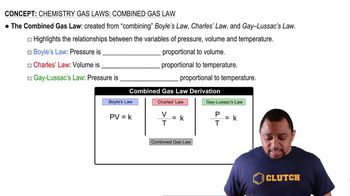Methanol (CH3OH) can be made by the reaction of CO with H2: CO(𝑔) + 2 H2(𝑔) ⇌ CH3OH(𝑔) (a) Use thermochemical data in Appendix C to calculate ΔH° for this reaction.
Ch.15 - Chemical Equilibrium
Chapter 15, Problem 67
Ozone, O3, decomposes to molecular oxygen in the stratosphere according to the reaction 2 O31g2¡3 O21g2. Would an increase in pressure favor the formation of ozone or of oxygen?
 Verified step by step guidance
Verified step by step guidance1
Identify the reaction: 2 O_3(g) \rightarrow 3 O_2(g).
Apply Le Chatelier's Principle, which states that a system at equilibrium will adjust to counteract any changes imposed on it.
Consider the effect of pressure on the reaction. Increasing pressure favors the side with fewer moles of gas.
Count the moles of gas on each side of the reaction: 2 moles of O_3 on the left and 3 moles of O_2 on the right.
Determine which side is favored by increased pressure: the side with fewer moles, which is the reactants (O_3).

Verified video answer for a similar problem:
This video solution was recommended by our tutors as helpful for the problem above.
Video duration:
3mWas this helpful?
Key Concepts
Here are the essential concepts you must grasp in order to answer the question correctly.
Le Chatelier's Principle
Le Chatelier's Principle states that if a dynamic equilibrium is disturbed by changing the conditions, the position of equilibrium shifts to counteract the change. In the context of gas reactions, increasing pressure will favor the side of the reaction with fewer moles of gas, as this reduces the overall pressure.
Recommended video:
Guided course

Le Chatelier's Principle
Stoichiometry of the Reaction
The stoichiometry of the reaction 2 O3(g) → 3 O2(g) indicates that two moles of ozone decompose to produce three moles of oxygen. This means that for every two moles of ozone, three moles of oxygen are generated, resulting in an increase in the total number of gas moles when ozone decomposes.
Recommended video:
Guided course

Stoichiometry Concept
Gas Laws
Gas laws describe the behavior of gases under various conditions of pressure, volume, and temperature. According to the ideal gas law, increasing pressure at constant temperature will affect the equilibrium position of a reaction involving gases, influencing the amounts of reactants and products present.
Recommended video:
Guided course

Combined Gas Law
Related Practice
Textbook Question
Textbook Question
Methanol (CH3OH) can be made by the reaction of CO with H2: CO(𝑔) + 2 H2(𝑔) ⇌ CH3OH(𝑔) (b) To maximize the equilibrium yield of methanol, would you use a high or low temperature?
Textbook Question
Methanol (CH3OH) can be made by the reaction of CO with H2: CO(𝑔) + 2 H2(𝑔) ⇌ CH3OH(𝑔) (c) To maximize the equilibrium yield of methanol, would you use a high or low pressure?
Textbook Question
The water–gas shift reaction CO1g2 + H2O1g2ΔCO21g2 + H21g2 is used industrially to produce hydrogen.The reaction enthalpy is H = -41 kJ.(b) Could you increase the equilibrium yieldof hydrogen by controlling the pressure of this reaction? Ifso would high or low pressure favor formation of H2(g)?
Textbook Question
(a) Is the dissociation of fluorine molecules into atomic fluorine, F2(𝑔) ⇌ 2 F(𝑔), an exothermic or endothermic process?
Textbook Question
(b) If the temperature is raised by 100 K, does the equilibrium constant for this reaction increase or decrease?
